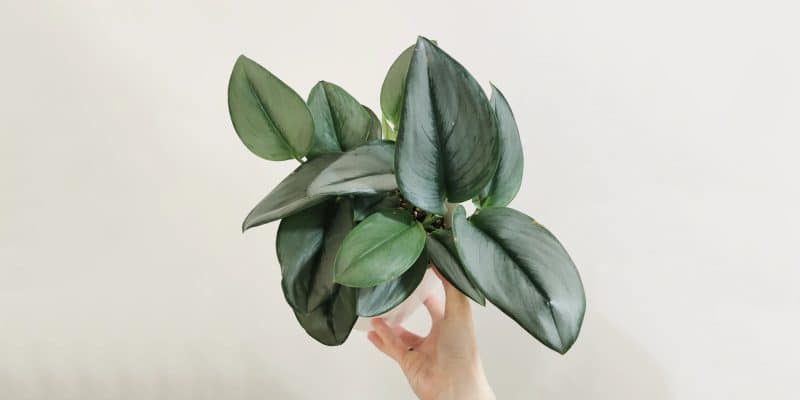Scindapsus treubii ‘Moonlight’ is a mysterious beauty that’s guaranteed to make your indoor garden feel like a magical, moonlit haven.
Scindapsus treubii is more than just a pretty face — it also boasts an extraordinary ability to purify the air in your home, as well as a deceptively compact look that spreads to a vine as it matures.
We’ll cover everything you need to know about Scindapsus treubii care, along with a propagation guide and solutions to the problems we see the most with this celestial beauty.
Table of Contents
Scindapsus Treubii Moonlight Plant Care Guide
History, Habitat, and Characteristics
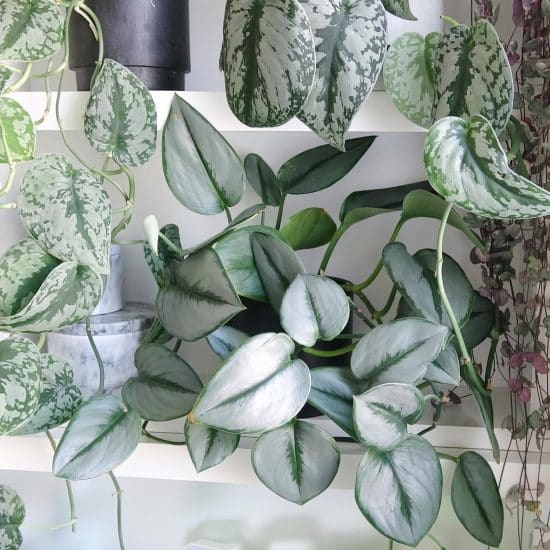
Scindapsus treubii ‘Moonlight’ originally comes from the lush forests of Southeast Asia, including Java, Borneo, and Indonesia. This tropical plant belongs to the aroid family, Araceae, making it a close cousin of the beloved pothos (formerly also called Scindapsus, now Epipremnum) and philodendron.
In its natural habitat, Scindapsus treubii can be found growing along forest edges, where it climbs trees in search of sunlight. It’s a plant that truly knows how to “branch out” in its quest for light, starting on the forest floor and producing shingling leaves that securely attach aerial roots to the tree bark.
As the plant climbs higher, its leaves transform, becoming longer, thinner, and darker to better capture available light. Talk about reaching for the stars!
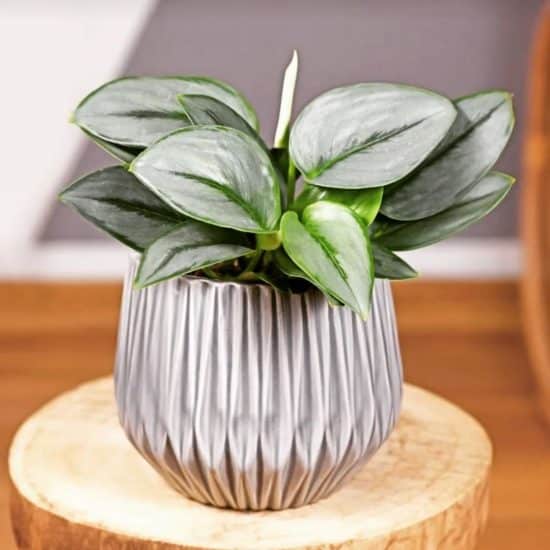
There are a few varieties of Scindapsus treubii, including ‘Dark Form’ and ‘Mint,’ both of which are rather hard to find in nurseries, but the enchanting Scindapsus ‘Moonlight’ is the more common. It’s a foliage plant known for its thick, shiny leaves that display a mesmerizing mix of silver and green to give it its nickname, Sterling Silver Scindapsus.
Fun fact: Scindapsus treubii is named in honor of the Dutch botanist Melchior Treub, a trailblazer in the fields of botany and plant taxonomy during the late 19th and early 20th centuries. So, not only do you get a beautiful plant, but you also get a piece of botanical history to brighten up your space!
Light
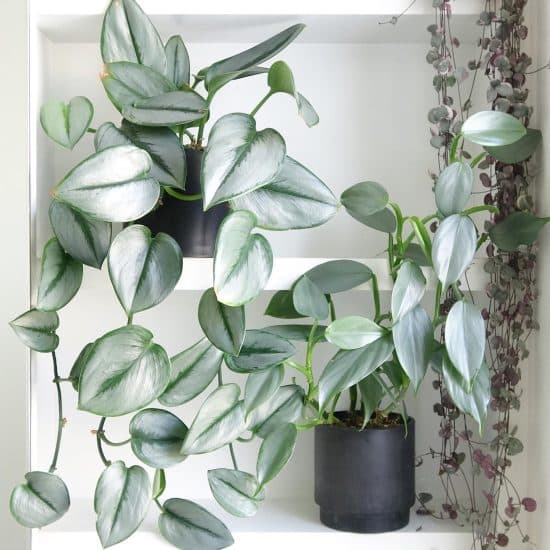
Navigating the lighting needs of your Sterling Silver Scindapsus doesn’t have to be a daunting task. With a bit of experimentation and observation, you’ll be able to provide the right amount of light for this low-maintenance plant.
A northeast-facing window with moderate light is a good starting point for your Scindapsus treubii ‘Moonlight’, but you’ll probably want to gradually introduce more light. Medium to bright indirect sunlight will showcase those striking leaves with a silvery sheen and keep your Sterling Silver plant looking its best.
More light equals more sterling silver, while low light brings out the milky green in the foliage. To ensure your Scindapsus treubii ‘Moonlight’ is getting the proper amount of light, watch out for these signs:
Too much light: If you spot yellowing or bleached leaves, your plant might be soaking up a bit too much direct sun. Additionally, stunted growth can also indicate excessive direct light exposure. To remedy this, move your plant to a less sunny spot or add a sheer curtain to provide some filtered light.
Not enough light: If your Scindapsus treubii plant has slowed its growth and the sterling silver variegation is turning green, it’s likely not getting enough indirect sunlight. Boost the brightness by moving the plant to a sunnier location or supplementing with a full-spectrum grow light.
Our lighting tips:
- Provide your Sterling Silver plant with bright, indirect sunlight.
- An east-facing window or a brightly lit south-facing room several feet from the window would be ideal placement.
- Experiment with different locations to find the perfect balance of light for your Scindapsus treubii ‘Moonlight.’
- If you need to provide extra light for your Scindapsus treubii ‘Moonlight’ plant, opt for an energy-efficient LED or full-spectrum grow light.
Water
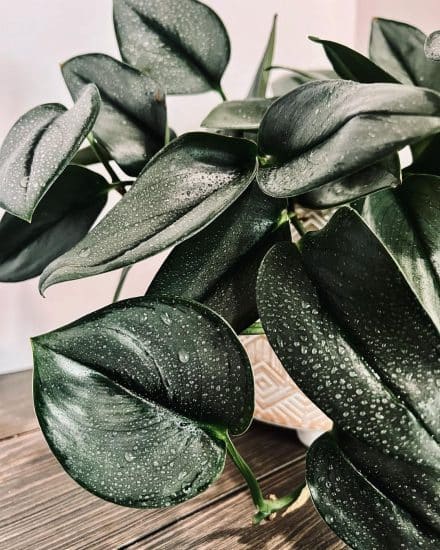
As an epiphytic creeper, Scindapsus treubii ‘Moonlight’ tolerates less water than many other tropical plants but still needs an adequate watering routine. The trick is to water thoroughly when the soil is almost completely dry.
Inadequate watering can leave your Scindapsus treubii ‘Moonlight’ parched and unhappy. You’ll notice drooping leaves or a wilted appearance, and in more severe cases, the edges of the leaves may turn brown and crispy. To remedy this, adjust your routine by either watering it more frequently or giving it more water when it’s dry.
Too much water, on the other hand, can result in yellow leaves and mushy stems. If you find that the leaves are turning yellow, especially at the base, or if the potting mix has a foul odor, it’s time to ease up on the watering and allow the well-draining soil to dry out thoroughly between waterings.
Our watering tips:
- The more light your Scindapsus treubii ‘Moonlight’ gets, the more water it will need, and vice versa.
- Poke your finger into the soil and water thoroughly when it’s almost dry.
- Choose a pot with drainage holes to prevent overwatering.
Temperature and Humidity
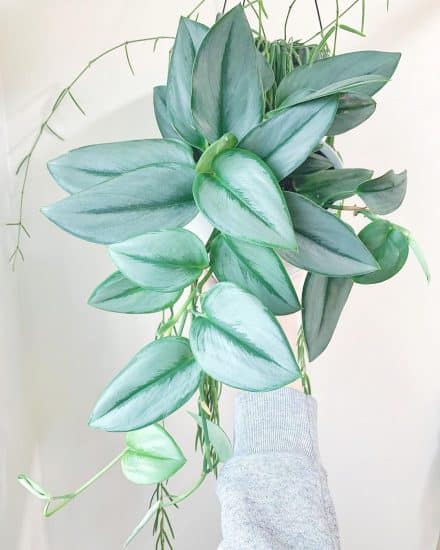
Ensuring the right temperature and humidity for your Scindapsus treubii ‘Moonlight’, a tropical plant with tropical needs, is key to nurturing a thriving plant.
The Scindapsus treubii ‘Moonlight’ is adaptable, comfortable in a range of 60-80°F (15-27°C), but it can brave cooler temperatures, even near a window in winter! But don’t push your luck — frost damage, characterized by curled leaves, can strike when temperatures dip below freezing. If that happens, move your plant away from a drafty window or door.
This houseplant appreciates a little moisture in the air but doesn’t demand high humidity all the time. Aim for a humidity sweet spot of 40%-60% to keep your plant content. Wilting leaves or browning tips? Too little humidity might be the culprit. Conversely, yellowing leaves could suggest that the air is too damp.
To raise humidity:
- Try the classic pebble tray method — fill a tray with water and pebbles and place your plant on top. The water will evaporate, delivering a mini moisture boost.
- Group your Scindapsus treubii ‘Moonlight’ with other leafy pals, since clustering houseplants makes for a humid microclimate through transpiration.
- Add a humidifier to maintain just-right humidity levels.
Soil and Planting
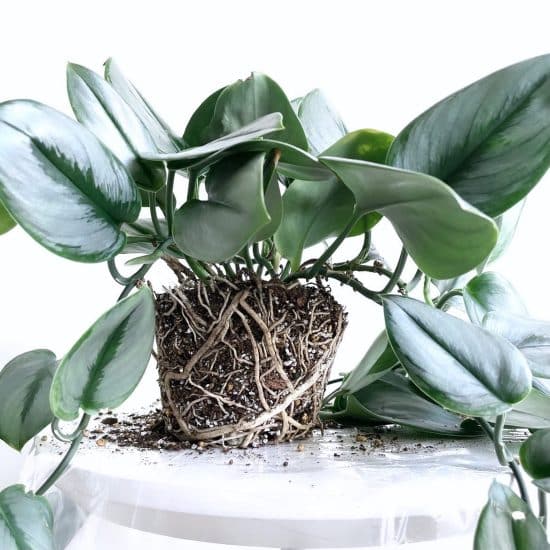
For a healthy and thriving Scindapsus treubii ‘Moonlight’, it’s crucial to start with the perfect soil mix. Choose a well-draining soil, such as a general-purpose or aroid mix, and incorporate plenty of perlite to ensure proper drainage. Adding orchid bark can help the soil retain moisture without drowning the roots.
Scindapsus treubii plants tend to grow rapidly. Therefore, repotting every 2-3 years in spring is necessary to prevent the roots from becoming too crowded. When choosing a new nursery pot, opt for one that’s only slightly larger than the current one and make sure it has ample drainage holes.
During the spring and summer months, your Scindapsus treubii ‘Moonlight’ will benefit from fertilization, which can supercharge your plant’s growth. Stick to nitrogen-rich or well-balanced fertilizers, such as a 20-10-10 formula. Fertilize this variety every second watering for optimal results, and make sure to dilute.
Keep an eye out for signs of over-fertilization, such as yellowing leaves, burned leaf tips, or stunted growth. If you spot any of these issues, flush the soil with tap water to remove excess fertilizer. Consider cutting back on your fertilizing schedule or diluting your fertilizer more to prevent further damage.
Propagation
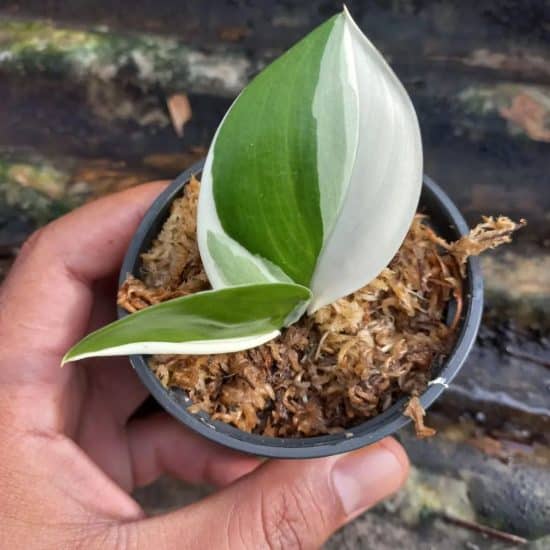
Propagating Scindapsus treubii ‘Moonlight’ is the best way to get more of them, especially considering they can be expensive and rare. With this guide, you’ll learn how to create new plants from leaf or stem cuttings.
Propagating Scindapsus treubii ‘Moonlight’ with leaf or stem cuttings:
- Pick a vibrant leaf or stem from your Scindapsus treubii ‘Moonlight’ plant, ensuring it has at least one healthy node (the bump where the leaf joins the stem).
- Snip the leaf or stem beneath a node using clean, sharp scissors or gardening shears for a precise cut. If using stems, remove the bottommost leaves.
- Prep a small container filled with damp, well-draining soil or perlite. Coconut coir is also a good rooting medium for Scindapsus treubii. In a pinch, plain water works too!
- Nestle the cutting into the container, burying the lowest nodes in the medium. Be sure that no leaves are in the rooting medium. This can lead to rotting.
- Place the container in a warm spot with indirect light, away from harsh direct sun that could burn the leaf, and keep the soil moderately moist.
- Watch for new growth emerging from the cutting over the next few weeks to a month. Once roots form, transfer the cutting to a larger pot with well-draining soil.
Our propagation tips:
- Don’t worry if Scindapsus treubii ‘Moonlight’ plants seem slow to propagate at first; they’ll grow rapidly once they’ve taken root.
- Use single-node, single-leaf cuttings for the highest chance of propagation success.
- Remember, Scindapsus treubii ‘Moonlight’ is super beginner-friendly, so don’t be afraid to give propagation a try!
Common Issues
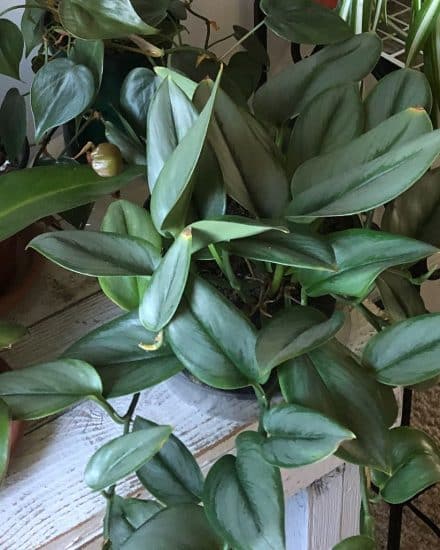
Yellow Leaves
Yellow leaves on your Scindapsus treubii ‘Moonlight’may signal overwatering, but don’t worry — some yellowing is normal as older leaves age and fall off. If you spot many yellow leaves, take a closer look at your watering habits.
Let your soil dry out a bit between waterings and ensure your pot provides proper drainage. Persistent problems may call for repotting in fresh soil and reducing water to stave off issues with the roots.
Curling Leaves
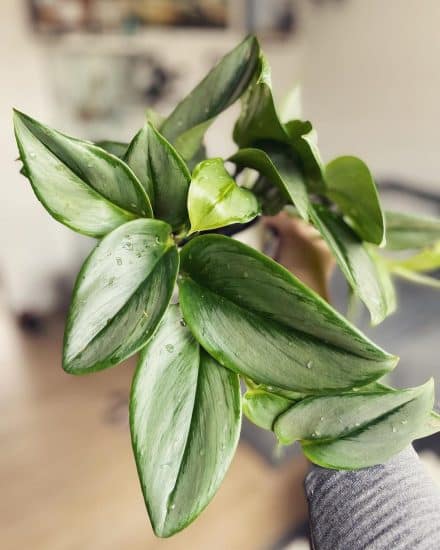
Curled leaves on your Scindapsus treubii ‘Moonlight’ often point to watering issues, either too much or too little. To tackle this, establish a consistent watering schedule while allowing the soil to dry out between sessions.
If you’ve already done this and the issue lingers, examine your plant’s surroundings. Scindapsus plants thrive with a balance of indirect sunlight and humidity (adjust light exposure or use a humidifier to assist).
Furthermore, offering support, such as a stake or trellis, can promote proper growth and prevent the plant from slipping back into its juvenile phase.
Pests and Diseases
Scindapsus treubii ‘Moonlight’ plants are generally low maintenance and resistant to pests and diseases. However, if they’re neglected for extended periods, they might face issues like mealybugs and rot.
Mealybugs
Scindapsus treubii ‘Moonlight’ plants can occasionally struggle with mealybug infestations. These little critters appear as small, white, cotton-like insects on your plant’s leaves and stems. They feed on the plant’s sap, producing a sticky residue known as honeydew.
If you suspect a mealybug infestation, first, wipe off the insects using a cotton swab dipped in rubbing alcohol or a mild dish soap mixture. After removing as many mealybugs as possible, treat your plant with neem oil (be sure to follow the application instructions on the bottle).
Keep a close eye on your plant, as you might need to repeat the treatment to completely eliminate these pesky bugs.
Root Rot
Root rot can be a problem for Scindapsus treubii ‘Moonlight’ plants, especially if they’re overwatered or left sitting in damp soil. This fungal disease causes the roots to become soft, mushy, and discolored. Symptoms to look out for include yellowing or wilting leaves, stunted growth, and a moldy or musty smell from the soil.
To address rot, start by removing the plant from its pot and examining the roots for any mushy, slimy, or discolored areas. Next, trim away the infected roots using sterilized scissors, and let the healthy roots air-dry for a few hours.
Finally, repot your plant in well-draining soil (consider adding perlite or pumice for better aeration and drainage). Going forward, be cautious with watering, allowing the top inch or two of soil to dry out between waterings, and never place your Sterling Silver Scindapsus in a pot without drainage holes.
Conclusion
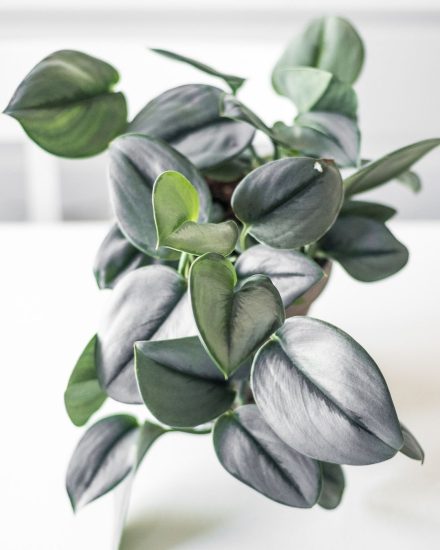
That’s it for our Scindapsus treubii ‘Moonlight’ care guide! You should feel well-equipped to embrace this enchanting houseplant and give it the care it deserves.
Scindapsus treubii ‘Moonlight’ care summary:
- Aim for medium to bright indirect light to bring out the beautiful silver and green variegation in the leaves.
- Establish a balanced watering routine, allowing the soil to dry out between waterings and ensuring proper drainage.
- Provide a comfortable temperature range of 60-80°F (15-27°C) and maintain humidity levels of 40%-60% for a happy plant.
- Use a well-draining potting mix, incorporating perlite and orchid bark for optimal drainage and root health.
- Fertilize during the growing season with a nitrogen-rich or well-balanced fertilizer for best results.
We hope this guide helps you on your journey to nurturing a thriving Scindapsus treubii ‘Moonlight.’ If you have any questions or need further assistance, please don’t hesitate to reach out.
Share your plant adventures with us in the comments below, and may your indoor garden shimmer with the glow of moonlit magic!
FAQ
Is Scindapsus treubii Moonlight rare?
While Scindapsus treubii ‘Moonlight’ isn’t a particularly common houseplant, it isn’t necessarily classified as “rare,” though the Scindapsus treubii ‘Dark Form’ and ‘Mint’ cultivars are.
Moonlight’s striking silver leaves and adaptable nature make it a desired addition to many indoor plant collections, but it may not be as readily available as some other more common species.
Keep an eye out at local nurseries and online shops. These unique plants can sometimes be found hiding among their more ubiquitous plant cousins.
How big does Scindapsus treubii Moonlight get?
When provided with ample room to grow and a supportive surface (like a moss pole or trellis), it can climb up to several feet in height, as much as 6-8 feet in the best conditions.
Alternatively, when kept in a hanging basket, its trailing vines can grow several feet long. With proper care and patience, you’ll witness this stunning plant flourish and expand in your home.
Is Scindapsus Moonlight a philodendron?
No. While the Scindapsus treubii ‘Moonlight’ might share some similarities with philodendrons in appearance, it is not a philodendron. Both plants belong to the Araceae family, but ‘Moonlight’ falls in the Scindapsus genus, while Philodendron is a separate genus under the same family.
Do Scindapsus treubii Moonlight like to be root bound?
Scindapsus treubii Moonlight can tolerate being root bound to a certain extent. However, this doesn’t mean it prefers to be overly crowded in its pot. When the roots become too tightly packed within its container, it may experience slower growth and reduced vigor.
That being said, occasional repotting (every 2-3 years) into a slightly larger pot with fresh soil will help maintain the health of the plant and promote continued growth. Keep an eye on the roots to identify when it’s time to give your ‘Moonlight’ treubii some extra breathing room.

